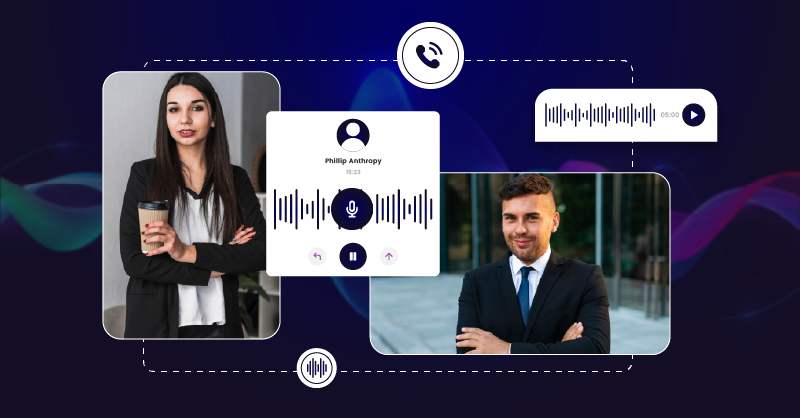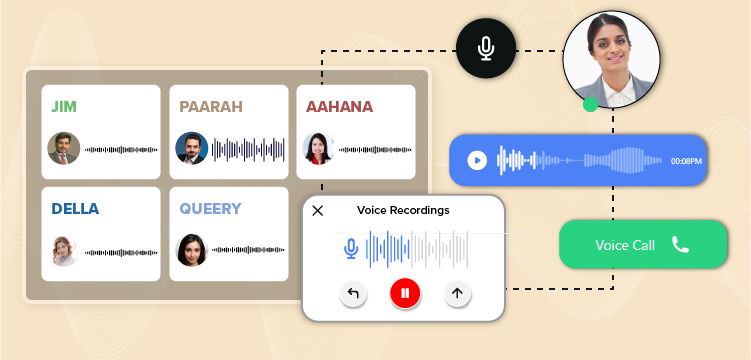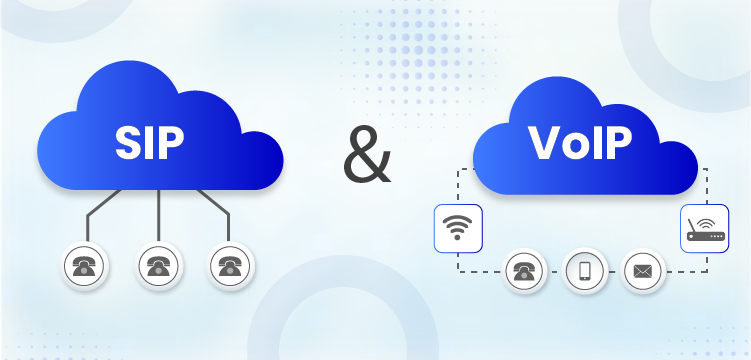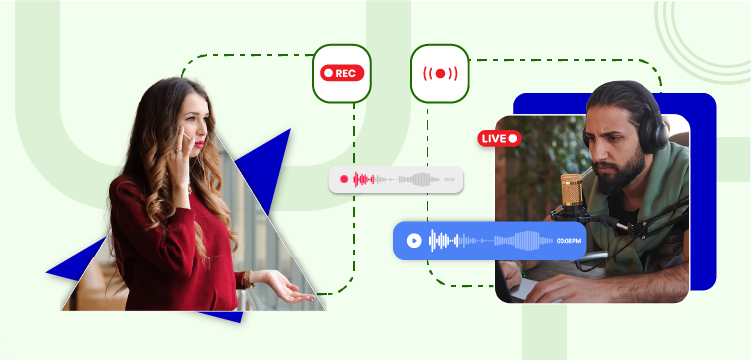Top 10 Features of Voice Call API 2025

We believe that you’ll hear the word “interconnected digital landscape” on the business premises.
It’s not just any acronym; it’s actually the creation of a communication ecosystem for any business. The customer expects real-time communication with businesses.
In this dynamo-sphere, without any doubt, the role of Voice Calls functionalities in applications is no longer just a luxury.
Integrating Voice Call APIs has emerged as supporting voice in real-time business communication.
In this article,
let’s deep dive into the top 10 features of voice call API. Moreover, let’s explore how white-label voice chat API can contribute to creating sophisticated and customized voice call experiences.
Table of Contents
What is Voice Call API?
Voice API is a tool for software developers or businesses to make and receive phone calls through the Internet. Unlike traditional phone lines, users can integrate voice call API into any existing web application.
Behind the scenes, the API bridges the Public Switched Telephone Network (PSTN) and apps that are connected to the Internet.
The Necessity of Business Voice Calls in Numbers
- 73% of customers expect real-time support from businesses
- 60% of customers prefer to contact businesses by phone
- Compared to email, voice calls are 10x more effective for lead nurturing.
Top 10 Features of Voice Call API – The In and Out for Professional Communication
Before we start to explore the benefits, anchor in your thought that choosing the best voice call API provider with a white-label solution will let you experience the below-mentioned features (in other words, the most advanced and expected features among users).
1. Unlimited Group Voice Calls
With the white-label voice chat API, you’re not restricted just to one-on-one voice calls. With the high-end compatibility, you can change your existing system into an unlimited audio conferencing hub in a seamless way.With high-quality calls and adding the group or panel members into the calls, integrating voice call API will be more beneficial for businesses with huge teams, enterprises with recruitment teams and telecom industries.
Also, to manage and control the ongoing call, voice API can enable features such as speaker identification, overall call control for admins, call muting, and more.
Highlights of integrating white-lable voice call API
- HQ voice call to connect multiple people across any platform
- Screen sharing for not just speaking but sharing thoughts along with the screen.
- For efficient call routing, you can transfer calls to other team members or departments, which will be helpful in the Audio call center software

2. High Quality SIP & VoIP Calls
With Phone call API, you can enable the most cost-effective yet potential voice communication within your existing system. Both SIP (Session Initiation Protocol) and VoIP (Voice Over Internet Protocol) provide complete flexibility and scalability to elevate communication to the next level.
As your user base grows or changes in business needs, SIP & VoIP calls in API integration let you scale the capabilities without expensive hardware installations.
Highlights of SIP & VoIP Calls with Voice Call API Integration
- The integration of SIP and VoIP in API ensure the clear and reliable call quality over traditional phone lines.
- SIP gives complete control over the communication infrastructure
- With SIP & VoIP integration you can enable beyond voice calls such as video conferencing, call forwarding, voicemail to email, etc.

3. Live Audio Broadcasting & Call Recording
Another interactive use case of voice API is live audio broadcasting. To reach a wide audience and foster real-time deeper engagement without any boundaries.
With audio broadcasting, you can educate your customers about products or services through engaging webinars, presentations, and live Q&A sessions. You can also send real-time updates and announcements to keep everyone informed.
Call recording using voice chat API supports the effort of capturing valuable discussions for future reference. The recording feature in call centre software will help record the agents’ calls for quality assurance programs and training.
Highlights of Broadcasting & Recording in Self-Hosted Voice API Solutions
- Enable two way real time broadcasting rather than sending recorded one
- Share and receive the recording through the chat without any upload limit
- Easy integration of broadcasting and recording functionalities with extensive customization.

4. Analytics and Reporting
Utilizing analytics is essential for enhancing the voice quality of communication. Call Analytics provides an overview of performance and user engagement.
Voice APIs should have the ability to capture comprehensive analytics metrics. This includes detailed call logs, call quality, duration of calls and user reviews.
White-Label Voice APIs Highlights
With the self-hosted voice call API, you can get detailed call history, which includes date, time, and duration of previous calls, and call history.

5. Custom Security in Voice Call API
While voice calls transfer between two ends of users, it’s crucial to safeguard users’ data. Voice chat API provides custom security to secure data and privacy.
Apart from securing on-call data, protecting the voice application will be another factor that the voice app API provider must consider. The extensive security features of voice API include user authentication, multi-factor authentication, chat moderation, and blocked contacts control.
Highlight Features of White-label Voice Chat API in Security
- End-to-end encryption of all the voice calls that the sender and receiver can access.
- Many voice API providers offer LDAP/SSO security to shield the logins and user credentials.
- Biometric protection supports fingerprint and face recognition to access the application.

6. Answering Machine Detection (AMD)
AMD, also known as Automatic Machine Detection, is a technology that enables businesses to determine whether a call made by a customer is from a human or a voicemail system.
In this way, human agents can easily skip calls answered by the voice system and focus on the calls that are important and need guidance. You might now wonder how it works? AMD utilizes audio pattern recognition and timing to identify the type of call, providing customized responses to customers, thereby enhancing call efficiency and performance.
Key Highlights Of AMD Voice Call APIs
- Automatically detects human and voicemail calls without any glitch
- Minimize agent idle time and boost their productivity
- Enhances efficiency while running outbound campaigns
7. Interactive Voice Response (IVR) & Voice Bots
IVR is a process that enables callers or users to interact with an automated phone system or menu using voice commands and inputs. This means that when you make a call to a business, a computerized voice system answers with different menu options, and callers can select the service they require by entering the corresponding number.
Based on the option selected, calls will either be answered by voice bots that help them resolve issues easily or directed to specific departments, where a human staff member will coordinate with them to sort out errors. Additionally, having an IVR will enable businesses to provide prompt responses to clients and streamline call handling.
Key Highlights Of IVR Voice Call APIs
- Voice bots can help check bank balances and reduce wait times on calls.
- It reduces overall operational costs and enhances the customer experience by providing service around the clock.
- You can add IVR with natural voices, simple menu options, and multiple languages.
8. Call Control & Media Streaming
Call control is a feature that allows businesses to manage calls during a conversation, such as putting them on hold, transferring them to specific departments, or recording them for later use. On the other hand, media streaming is a service that gives access to live audio for recording or transcription usage.
This type of feature is particularly helpful for service centers, call centers, or voice chat apps that require speech-to-text transcription.
Major Highlights
- Helps to create customized user experience with features they need
- Permits to access live audio that can be used for transcription or analysis purposes.
- Can easily manage calls with options like transfer, hold, and record.
9. Number Provisioning and Masking
With the help of third-party API providers like MirrorFly, it’s easy for you to assign phone numbers to your VoIP phones, allowing you to engage with your customers or clients without sharing personal information.
Additionally, having numbers masked can make your business appear more trustworthy and credible. You can see this type of feature mostly in customer marketplace or customer service centers.
Key Highlights Of Voice Call APIs For Number Masking
- Allows you to assign phone numbers instantly, enabling you to make both local and international calls.
- By masking numbers, you can hide the original number and boost privacy
- Allows you to make calls to any part of the world
10. Speech-to-Text (STT) & Text-to-Speech (TTS)
STT and TTS are two technology types that are currently revolutionizing the communication sector. TTS is just as it sounds – converting written text to human speech, and TTS systems use advanced machine learning algorithms to understand language and replicate human voice.
STT is the opposite of text-to-speech, which converts voice or spoken words into machine-readable text. It uses advanced speech recognition algorithms to detect signals and interpret grammar, and transcribe to text in real-time.
Key Highlights Of Whitelabel Voice Call APIs
- STT enables hands-free operation, ensuring accuracy and reliability.
- STT also allows for multi-tasking. Whereas TTS increases accessibility for individuals with disabilities.
- TTS technology can generate voices that are both prominent and human-like, without errors.
Bottom Line
There is no replacement for voice calls, even though the digital, interconnected world is evolving. From enhancing voice call quality to securing communication and streamlining call management, these voice call APIs are necessary for customer engagement.
Still, you can find a way to build the application from scratch; the time and development cost to integrate API is so beneficial. Consider self-hosted voice API from leading providers like MirrorFly, Apphitect, and RocketChat, which will give you all the excellent features of both on-cloud and on-premise hosting. This will support the security and privacy of your voice calls effectively.
Related Reads
In-app Chat and Messaging Use Cases
AI Voice Agent API and SDK
Ready to Develop Your Self-Manged Voice Call Apps
Drive 1+ billions of conversations on your apps with highly secure 1000+ real-time Communication Features.
Contact Sales200+ Happy Clients
Topic-based Chat
Multi-tenancy Support
